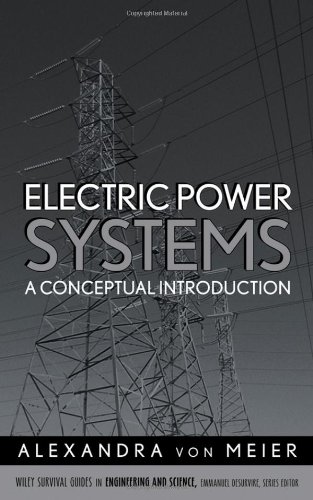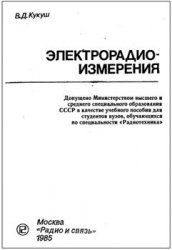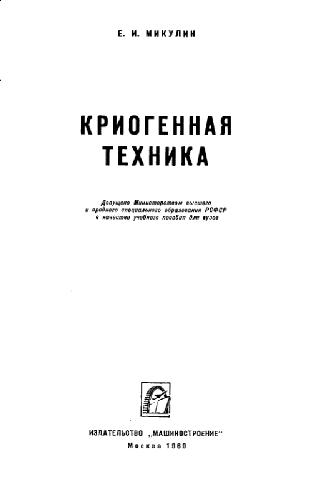Alexandra von Meier0471178594, 9780471178590, 9780470036402
Electric Power Systems explains and illustrates how the electric grid works in a clear, straightforward style that makes highly technical material accessible. It begins with a thorough discussion of the underlying physical concepts of electricity, circuits, and complex power that serves as a foundation for more advanced material. Readers are then introduced to the main components of electric power systems, including generators, motors and other appliances, and transmission and distribution equipment such as power lines, transformers, and circuit breakers. The author explains how a whole power system is managed and coordinated, analyzed mathematically, and kept stable and reliable.
Recognizing the economic and environmental implications of electric energy production and public concern over disruptions of service, this book exposes the challenges of producing and delivering electricity to help inform public policy decisions. Its discussions of complex concepts such as reactive power balance, load flow, and stability analysis, for example, offer deep insight into the complexity of electric grid operation and demonstrate how and why physics constrains economics and politics.
Although this survival guide includes mathematical equations and formulas, it discusses their meaning in plain English and does not assume any prior familiarity with particular notations or technical jargon. Additional features include:
* A glossary of symbols, units, abbreviations, and acronyms
* Illustrations that help readers visualize processes and better understand complex concepts
* Detailed analysis of a case study, including a Web reference to the case, enabling readers to test the consequences of manipulating various parameters
With its clear discussion of how electric grids work, Electric Power Systems is appropriate for a broad readership of professionals, undergraduate and graduate students, government agency managers, environmental advocates, and consumers.
Table of contents :
ELECTRIC POWER SYSTEMS……Page 3
CONTENTS……Page 9
Preface……Page 15
ACKNOWLEDGMENTS……Page 17
1.1.1 Introduction……Page 19
1.1.2 Charge……Page 20
1.1.3 Potential or Voltage……Page 21
1.1.5 Conductivity……Page 23
1.1.6 Current……Page 24
1.2 Ohm’s law……Page 26
1.2.1 Resistance……Page 27
1.2.2 Conductance……Page 28
1.3.1 Static Charge……Page 29
1.3.2 Electric Circuits……Page 30
1.3.4 Electric Shock……Page 31
1.4 Resistive Heating……Page 32
1.4.1 Calculating Resistive Heating……Page 33
1.4.2 Transmission Voltage and Resistive Losses……Page 35
1.5.1 The Field as a Concept……Page 36
1.5.2 Electric Fields……Page 37
1.5.3 Magnetic Fields……Page 39
1.5.4 Electromagnetic Induction……Page 42
1.5.5 Electromagnetic Fields and Health Effects……Page 43
1.5.6 Electromagnetic Radiation……Page 44
2.1 Modeling Circuits……Page 48
2.2 Series and Parallel Circuits……Page 49
2.2.1 Resistance in Series……Page 50
2.2.2 Resistance in Parallel……Page 51
2.2.3 Network Reduction……Page 53
2.2.4 Practical Aspects……Page 54
2.3 Kirchhoff’s Laws……Page 55
2.3.1 Kirchhoff’s Voltage Law……Page 56
2.3.2 Kirchhoff’s Current Law……Page 57
2.3.3 Application to Simple Circuits……Page 58
2.3.4 The Superposition Principle……Page 59
2.4 Magnetic Circuits……Page 62
3.1.1 Historical Notes……Page 67
3.1.2 Mathematical Description……Page 68
3.1.3 The rms Value……Page 71
3.2.1 Inductance……Page 73
3.2.2 Capacitance……Page 76
3.2.4 Admittance……Page 82
3.3.1 Definition of Electric Power……Page 84
3.3.2 Complex Power……Page 86
3.3.3 The Significance of Reactive Power……Page 91
3.4.1 Phasors as Graphics……Page 93
3.4.2 Phasors as Exponentials……Page 96
3.4.3 Operations with Phasors……Page 98
4. Generators……Page 103
4.1 The Simple Generator……Page 104
4.2.1 Basic Components and Functioning……Page 110
4.2.2 Other Design Aspects……Page 115
4.3 Operational Control of Synchronous Generators……Page 117
4.3.1 Single Generator: Real Power……Page 118
4.3.2 Single Generator: Reactive Power……Page 119
4.3.3 Multiple Generators: Real Power……Page 125
4.3.4 Multiple Generators: Reactive Power……Page 130
4.4 Operating Limits……Page 133
4.5.1 General Characteristics……Page 136
4.5.2 Electromagnetic Characteristics……Page 138
4.6 Inverters……Page 141
5. Loads……Page 145
5.1 Resistive Loads……Page 146
5.2 Motors……Page 149
5.3 Electronic Devices……Page 152
5.4 Load from the System Perspective……Page 154
5.4.1 Coincident and Noncoincident Demand……Page 155
5.4.2 Load Profiles and Load Duration Curve……Page 156
5.5 Single- and Multiphase Connections……Page 158
6.1.1 Historical Notes……Page 162
6.1.2 Structural Features……Page 165
6.1.3 Sample Diagram……Page 167
6.1.4 Topology……Page 168
6.1.5 Loop Flow……Page 171
6.1.6 Stations and Substations……Page 174
6.1.7 Reconfiguring the System……Page 176
6.2 Three-Phase Transmission……Page 177
6.2.1 Rationale for Three Phases……Page 178
6.2.2 Balancing Loads……Page 181
6.2.3 Delta and Wye Connections……Page 182
6.2.5 Three-Phase Power……Page 184
6.2.6 D.C. Transmission……Page 185
6.3.1 General Properties……Page 186
6.3.2 Transformer Heating……Page 188
6.3.3 Delta and Wye Transformers……Page 191
6.4.1 Conductors……Page 193
6.4.2 Towers, Insulators, and Other Components……Page 197
6.5.1 Thermal Limits……Page 200
6.5.2 Stability Limit……Page 201
6.6 Voltage Control……Page 202
6.7.1 Basics of Protection and Protective Devices……Page 206
6.7.2 Protection Coordination……Page 210
7.1 Introduction……Page 213
7.2.1 Network Representation……Page 215
7.2.2 Choice of Variables……Page 216
7.2.4 Variables for Balancing Real Power……Page 219
7.2.5 Variables for Balancing Reactive Power……Page 220
7.2.6 The Slack Bus……Page 222
7.2.7 Summary of Variables……Page 223
7.3.1 Six-Bus Example……Page 224
7.3.2 Tweaking the Case……Page 228
7.3.3 Conceptualizing Power Flow……Page 229
7.4.1 Derivation of Power Flow Equations……Page 232
7.4.2 Solution Methods……Page 235
7.4.3 Decoupled Power Flow……Page 242
7.5 Applications and Optimal Power Flow……Page 244
8.1.1 Measures of Reliability……Page 247
8.1.2 Valuation of Reliability……Page 249
8.2 Security……Page 251
8.3.1 The Concept of Stability……Page 252
8.3.2 Steady-State Stability……Page 254
8.3.3 Dynamic Stability……Page 258
8.3.4 Voltage Stability……Page 267
8.4 Power Quality……Page 268
8.4.1 Voltage……Page 269
8.4.2 Frequency……Page 271
8.4.3 Waveform……Page 273
9. System Operation, Management, and New Technology……Page 277
9.1 Operation and Control on Different Time Scales……Page 278
9.1.1 The Scale of a Cycle……Page 279
9.1.2 The Scale of Real-Time Operation……Page 280
9.1.3 The Scale of Scheduling……Page 282
9.1.4 The Planning Scale……Page 285
9.2.1 Storage……Page 286
9.2.2 Distributed Generation……Page 289
9.2.3 Automation……Page 296
9.2.4 FACTS……Page 298
9.3.1 Operators and Engineers……Page 299
9.3.2 Cognitive Representations of Power Systems……Page 300
9.3.3 Operational Criteria……Page 303
9.3.4 Implications for Technological Innovation……Page 309
9.4 Implications for Restructuring……Page 310
Appendix: Symbols, Units, Abbreviations, and Acronyms……Page 316
Index……Page 320







Reviews
There are no reviews yet.